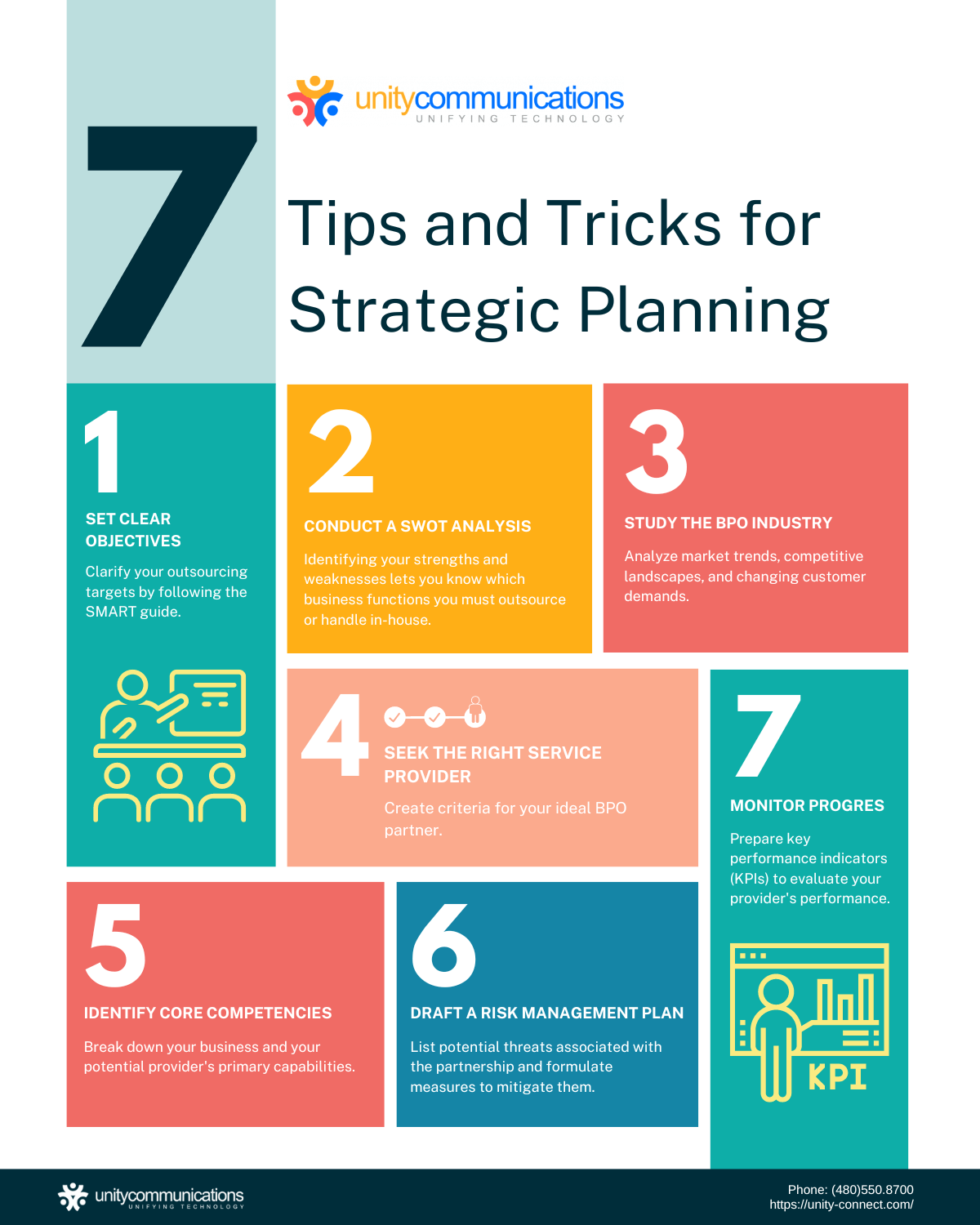Table of Contents
A wise entrepreneur develops a well-structured plan to benefit from business process outsourcing (BPO) in the long run. A strategically thinking businessperson values their partnership with a third party. A sharp-witted merchant emphasizes cost efficiency to produce superior outcomes.
Now, read back the first sentence. Do you have the same mindset?
Yes? No? Unsure?
Fret not! This article discusses key concepts to support your BPO long-term planning. You will also learn the best tips and tricks for establishing outsourcing and business growth strategies.
Importance of BPO Long-term Planning

When asked what BPO is, “hiring a provider to deliver outsourcing services” is the answer most people give. Increased productivity and enhanced product quality urge many organizations to entrust their front- and back-office functions to a third party.
In addition, recent statistics from Deloitte state that cost savings remain the primary driver of outsourcing; 57% of polled executives said so.
As such, most businesses consider hiring BPO companies as a short-term solution for their in-house struggles and backlogs. However, some take BPO long-term planning seriously. Here is why:
- Align strategic goals. A concrete plan ensures you and your service provider are on the same page. It assures that the BPO partner helps your enterprise achieve sustainable growth.
- Perform due diligence. Background checks and verification are crucial when seeking a healthy BPO partnership for the long term. Evaluating a vendor’s market position, expertise, and professional history lets you identify potential issues and resolutions beforehand.
- Streamline integration and planning processes. Working with a BPO provider requires a detailed integration strategy, especially for large-scale operations such as manufacturing. So you need an action plan to optimize your BPO partner’s strengths.
- Ensure balanced resource allocation. BPO long-term planning guides you in effectively distributing your resources between your non-core and core business functions.
- Manage risks. Collaborating with outsourcing firms involves the exchange of sensitive data and business assets. Thus, a well-organized plan assists in identifying and addressing related threats.
10 Key Elements of Successful BPO Long-term Planning

Long-term strategic planning before hiring BPO firms is your key to success. It involves several elements crucial to obtaining positive outcomes with your service provider.
- Strategic alignment. Long-term planning ensures the contractor’s goals and work strategies match yours. It helps avoid the hassle of conflicts and misunderstandings.
- Market analysis. Studying the latest market and BPO trends provides essential insights for decision-making. Moreover, monitoring consumer demands with the vendor assists in your planning to attain customer satisfaction and retention.
- Resource planning. A well-organized resource plan describes dividing funding equally between your primary initiatives and outsourcing projects. It informs you of any resource gaps and ways to address them.
- Contract negotiation. Whether you seek IT or call center support, securing a prolonged partnership requires careful negotiation with your ideal provider. As part of BPO long-term planning, you must discuss all your terms, conditions, and expectations with the third-party company.
- Service-level agreement (SLA). Drafting an SLA comes before, during, or after contract negotiation. It contains all service requirements, rules, payment conditions, and performance metrics for working with a third party.
- Risk management. BPO long-term planning includes creating a risk management framework. This strategy outlines practical solutions to mitigate potential risks that impact your partnership, such as cyberattacks and regulatory changes.
- Knowledge transfer. Setting up a knowledge transfer method establishes transparency between you and your service provider. The transfer method should securely and effectively facilitate the sharing and accessing relevant data for smooth collaboration.
- Relationship management. Maintaining a good relationship with your BPO partner allows you to maximize long-term benefits. You need a coherent relationship management process to ensure seamless communication and coordination despite location and availability barriers.
- Innovation. BPO long-term planning involves exploring innovative ways to achieve higher levels of quality services and client satisfaction ratings. Close cooperation with your provider helps identify which advanced solutions best fit your requirements.
- Continuous improvement. Have a strategy for tracking third-party progress and output. This factor helps you know whether the BPO partner streamlines your non-core functions, improves customer service, and contributes to growth. The resulting insights also notify you of which issues need urgent intervention.
7 Actionable Tips and Tricks for Strategic Planning

A recent study states that strategic planning supports a company’s long-term aptitude and competence. Planning also boosts profitability, enterprise expansion, and market share growth. Moreover, implementing a business plan template streamlines and guides these strategic efforts.
However, do you know where to start your BPO long-term planning? Allow us to help you through this business process outsourcing guide.
Define clear objectives. Set specific, measurable, achievable, relevant, and time-bound (SMART) goals. Every BPO model underscores the importance of such objectives. When partnering with a service provider, they are a focal point for your initiatives and resource allocation.
Perform a SWOT analysis. Identify your strengths and weaknesses within your organization. This analysis guides you in determining which business functions to outsource and which to manage in-house. It also aids in aligning your strategies with market opportunities and preparing to address potential threats.
Study the BPO industry. During your long-term BPO planning, delve into the BPO industry. Analyze market trends, competitive landscapes, and evolving customer demands. The insights gathered from this research inform your decision-making processes and budget planning.
Find the right service provider. Establish criteria for selecting your ideal BPO partner. Ensure they have relevant experience in your industry and can proficiently deliver the required services. Additionally, seek a vendor with a proven track record, an outstanding reputation, and positive client feedback.
Identify core competencies. Break down your business and your potential provider’s core capabilities. Collaborate closely to strategize, enhance, integrate, and leverage your strengths. This approach allows you to differentiate your offerings from competitors and bring added value to your customers.
Develop a risk management plan. Incorporate risk management into your long-term BPO planning. Identify potential threats associated with the partnership and devise strategies to mitigate them effectively.
Monitor progress. Establish an efficient system for tracking BPO progress and output. Additionally, prepare key performance indicators (KPIs) to assess your provider’s performance. These elements serve as valuable tools for identifying areas of improvement and fine-tuning your BPO approach as needed.
The Bottom Line
Although outsourcing might be a temporary solution to your high operating costs and huge backlogs, drafting a concrete strategy benefits you from this business strategy in the long run.
Know the importance of BPO long-term planning and the key to its success. The tips and tricks presented here should help you start successfully.
If you have any more questions about BPO long-term planning or BPO in general, let’s connect. Unity Communications values strategic business alignment and integration to help boost your efficiency and profitability.



